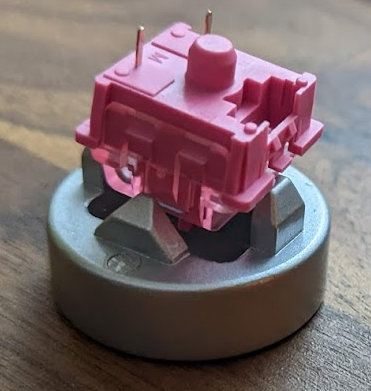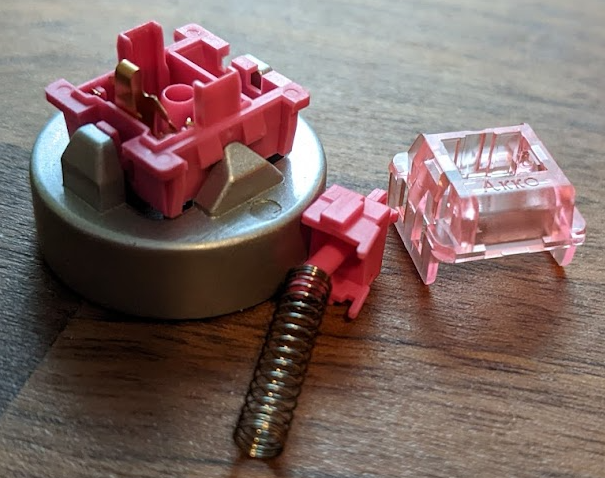Preface
A friend of mine recently brought up his custom mechanical keyboard while we were hanging out in voice chat, and at first, nobody understood why anyone would buy one. At that time, I had no clue that there are entire communities about building custom keyboards. With every sentence that was said, we got deeper into this community. We explored different YouTube channels, watched comparisons, and listened to sound tests.
Only a few hours later, all of us were hooked and wanted to build our own keyboards as well. This post will go over all the parts that are needed, what they are for, and what you need to watch out for.
Parts

There aren't that many parts. It's just the:
- Keyboard base (bottom)
- Keycaps (top left)
- Switches (top right)
Alright, let's get started!
Keyboard Base - Gamakay LK67

The most important part of your setup is the keyboard base. It'll define what your keyboard will look like. Depending on what you need and like, you can choose different sizes, materials, and features.
As you can see, it's a 65% keyboard (size reference) with a physical volume slider. The reason I wanted this keyboard, was not the volume slider but the Bluetooth support. I already have a wireless mouse (G502 Lightspeed) and I didn't want to make my cable management even worse than it already is. I also want to easily be able to take the keyboard with me (e.g. to the university campus). And, most importantly, it makes literally every setup look very clean and minimalistic. More on that later on.
When building a mechanical keyboard, you have two options for the keyboard base:
- Buy the parts individually and solder them yourself
- Buy an already assembled keyboard base
Obviously, when buying all the parts individually, you have a lot more control over your build, but it also requires more tools and work. However, since I don't have a soldering iron, I was fine with buying an already assembled keyboard base.
Things to watch out for:
- ANSI vs ISO keyboard layout: The differences between these layouts are very subtle and only affect very few keys. This is a good image, that shows how the Return and Shift keys differ. Why this is important will be explained in the keycaps section.
- Bluetooth support: Bluetooth on a mechanical keyboard isn't that popular, so you'll have fewer options to choose from. However, if you don't find a base that suits you, you can always buy the parts individually and assemble the base yourself.
- Keyboard size: Make sure to pick the correct size. Even when you don't have certain keys (e.g. F1-F12 or ~), you can still press them with a shortcut. On my keyboard, I can press F1 with
Fn+1or ~ withFn+Shift+Esc. Most keyboards have separate software where you can remap these keys or add additional macros.
Switches - Akko Rose Red

The keyboard switches will define what your keyboard sounds and feels like, so it's essential that you pick them carefully.
There are three switch categories:
- Linear: Smooth and consistent actuation.
- Tactile: Great feedback.
- Clicky: Like tactile, but with an additional click sound.
You should know the operating force metric. It defines how much force you need to fully press the key. In my case, the switches have $43gf \pm 5gf$ operating force. So they are much lighter compared to the $60gf$ operating force of my previous keyboard. There are also force travel graphs, which you can use to better understand how much the switch travels when it's pressed. For a much deeper explanation, I suggest reading this awesome article.
So how do you choose the switches? If you have the option, try them out in person. Either go to a store or find someone who has a mechanical keyboard. Otherwise, look for reviews on YouTube (or Invidious). You can compare the operating force and force travel with your current keyboard. Also, don't forget to listen to sound tests (both lubed and unlubed) because you don't want a keyboard that sounds terrible.
Things to watch out for:
- Tactile vs Linear: Choosing the correct switch type is important for the sound, feeling, and performance.
- Lubed vs Unlubed: Lubing the switches will result in a smoother and much more satisfying sound. It's purely subjective but, in my opinion, totally worth it.
- Amount of switches in one set: Switches are often sold in smaller amounts. For example, one Akko Rose Red set contains 45 switches, but the keyboard has more keys. So to fill an entire keyboard, you need to buy another set.
Keycaps - Akko

Now we come to the fun part. Just like the keyboard base defines the raw layout, the keycaps are the polish. You can go wild when choosing them. Do you want a keyboard with only pink/white/blue/red/green keycaps? Or blank keycaps without letters? Or keycaps that sound and look like you can eat them? Or maybe keycaps that are built for RGB lighting? You could even mix all the aforementioned keycaps if that's what you want (please don't actually do that).
Things to watch out for:
- ANSI vs ISO keyboard layout: As previously explained, you want to make sure that your keycaps have the correct sizes (e.g. for the enter or shift key). In my case, they included both layouts but it might be different in other sets.
- Profiles: The profile is the overall shape of the keycap. They can change the style and feel of your keyboard.
- Material: Make sure to buy keycaps that use PBT instead of ABS plastic. PBT keycaps are usually higher quality, more durable, and wear down less over time. This is a good article about the differences.
Lube - Krytox 205g0

When I first heard about lubing, I thought that it was a joke. It just sounded so surreal that anyone would lube switches just to make them sound better. And then I heard the difference. So if you are already building a mechanical keyboard, spending a few bucks more on lube doesn't hurt.
You might now think, can you even hear a difference? Well, let's try it out. One of these two recordings contains an unlubed key and one contains a lubed key.
| Recording 1 | Recording 2 |
|---|---|
Could you hear the difference? Which one do you think is the lubed one and which is the unlubed one? If you said left is lubed and right is unlubed, then you are correct. :)Answer
So how exactly does lubing work? First, you need to disassemble the switch (not the code this time :P). In my case, I had to put the switch into the gray thing. It was quite difficult to take apart the first switch, but you'll quickly get a feeling for it.


On the right, you can see the upper housing, stem, spring, and bottom housing. Each of these need to be lubed individually. Here's a good article that has an in-depth explanation of everything you need to do. You can also just look up a video that explains how you can lube your switch type.
Things to watch out for:
- Less is more: When applying the lube, don't overdo it! You can always come back later on and apply more, but it's much harder the other way around.
- Accessories: Splitting the switches into separate parts can be quite tricky. I can recommend spending a few more bucks on lube that comes with the required tools.
- Clicky, Linear, and Tactile switches: It's not recommended to lube clicky switches because you can accidentally convert them to tactile switches and destroy their unique sound. You can lube tactile switches, but it's generally recommended to use thin lube so you don't remove a lot of the tactile bump. Whereas, when lubing linear switches, you can do nothing wrong. They are already smooth and consistent, lube will only make them smoother and remove most of the rattling sound.
- Time: I completely underestimated the amount of time it takes to lube all the switches. You can roughly calculate the required time by multiplying the time it takes you to lube one switch, with the total switch amount. For example, I started around 8 PM and finished lubing all the switches around 2 AM. So it took me about 4-5 minutes to lube one switch. While this might sound like a lot, just hop on a call with your friends or watch a movie and the time will fly by.
Assembling everything
Now that we know what each part is for, we can put it all together. It's not that complicated, the pseudocode for it looks something like this:
let package = order_parts;
let = package.unpack;
// Lube the switch and insert it into the keyboard base
for key in keyboard_base.keys
// Find the matching keycaps and place it down
for key in keyboard_base.keys
Sound Comparison
My old keyboard was the Razer Ornata Chroma which I bought in July 2018. I didn't have any complaints about this keyboard up until I learned about custom mechanical keyboards. Here's what it sounds like:
And here's a sound test on my new custom mechanical keyboard:
Can you hear the difference? I still can't believe that I've been using the Razer keyboard for the last four years. Now that I can compare it against something, it sounds absolutely terrible. It also feels very inconsistent and has a much higher operating force.
Price
Alright, let's talk about money. In total, I spent around 160€ on the keyboard:
- Keyboard base: 55€
- Switches: 40€
- Keycaps: 50€
- Lube: 15€
And it was worth it in my opinion. As a programmer, I spend a lot of time on the computer, so why not make it more enjoyable?
Also, don't get scared if you don't want to spend this much money, because there are cheaper alternatives. You could get keycaps for 25€, switches for 40€ (these are the same switches I have) and a keyboard base for 45€. In total, that's 110€. And that keyboard is arguably even better than what you get for the same or higher price when buying "gaming keyboards".
Conclusion

Should you build a custom mechanical keyboard?
- Feeling and sound: I've been using mine for a few weeks now and I don't want to go back. I love the feeling and sound of my keyboard. I even regularly go on MonkeyType, not to improve or test my writing speed, but because I enjoy typing on it.
- Customizability: You can easily swap the switches, keycaps, or even the keyboard base. There are even people that add extra foam to further dampen the sound.
- Durability: If you are a heavy typer, switches of mechanical keyboards will usually last longer than the average membrane keyboard. And even if something breaks, you can easily replace it.
- Fun: Building and customizing a mechanical keyboard is a fun project.
If you spend lots of time in front of a computer, you should definitely build a mechanical keyboard. Trust me, you won't regret it. Feel free to reach out if you have any further questions or comments.
Thanks for reading!